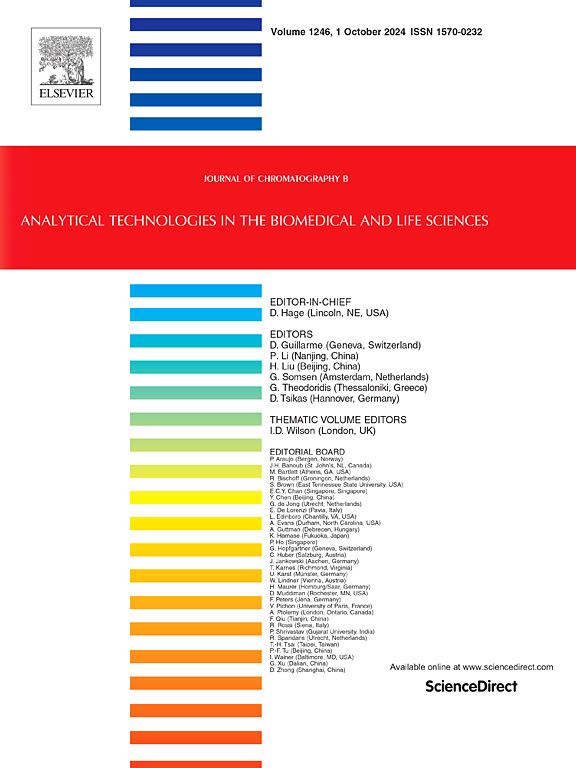超高效液相色谱-串联质谱法同时定量人血浆中总氯氮平和游离氯氮平及其两种代谢物的建立和验证
IF 2.8
3区 医学
Q2 BIOCHEMICAL RESEARCH METHODS
引用次数: 0
摘要
最近几项氯氮平(CLZ)及其代谢物的药代动力学研究表明,血浆CLZ浓度与疗效和不良反应有关,表明治疗性药物监测的有效性。虽然已经建立了几种总药物浓度和游离药物浓度的定量方法,但尚未建立超高效液相色谱-串联质谱(UHPLC-MS/MS)同时定量CLZ及其代谢物总药物浓度和游离药物浓度的方法。在本研究中,我们旨在建立一种同时定量测定血浆中总CLZ和游离CLZ及其两种主要代谢物n -去甲基CLZ (NDC)和CLZ n -氧化物(CNO)浓度的UHPLC-MS/MS方法。采用固相萃取法制备血浆样品,超滤得到游离部分。该方法符合美国食品药品监督管理局的验证要求。在较宽的校准范围内,总CLZ (10-1000 ng/mL)、总NDC和CNO (40-4000 ng/mL)、游离CLZ (2-2000 ng/mL)、游离NDC和CNO (0.8-800 ng/mL)均具有良好的线性。游离CLZ、NDC和CNO的超滤回收率分别约为60.0%、65.4%和72.8%。总药物回收率为91.4% ~ 107.5%,游离药物回收率为88.5% ~ 117.1%。此外,我们成功地测量了12例接受CLZ治疗的精神分裂症患者血浆样本中的总CLZ和游离CLZ、NDC和CNO浓度。我们已经成功开发并验证了一种定量测量血浆中总CLZ和游离CLZ、NDC和CNO浓度的方法。本文章由计算机程序翻译,如有差异,请以英文原文为准。
Development and validation of simultaneous quantification of total and free clozapine and its two metabolites in human plasma using ultra high-performance liquid chromatography coupled to tandem mass spectrometry
Several recent pharmacokinetic studies of clozapine (CLZ) and its metabolites have reported that plasma CLZ concentrations are associated with both efficacy and adverse effects, suggesting the usefulness of therapeutic drug monitoring. Although several quantification methods for total and free drug concentrations have been established, a simultaneous quantification method for total and free concentrations of CLZ and its metabolites using ultra high-performance liquid chromatography-tandem mass spectrometry (UHPLC-MS/MS) has not been developed. In this study, we aimed to develop a simultaneous quantitative measurement method for wide ranges of plasma concentrations of total and free CLZ and its two major metabolites, N-desmethyl CLZ (NDC) and CLZ N-oxide (CNO), using UHPLC-MS/MS. Plasma samples were prepared by solid phase extraction, and the free fraction was obtained by ultrafiltration. This method meets the validation requirements of the U.S. Food and Drug Administration. The quantification method demonstrated good linearity over wide calibration ranges for total CLZ (10–1000 ng/mL), total NDC and CNO (40–4000 ng/mL), free CLZ (2–2000 ng/mL), and free NDC and CNO (0.8–800 ng/mL). Ultrafiltration recovery rates for free CLZ, NDC, and CNO were approximately 60.0 %, 65.4 %, and 72.8 %, respectively. The total drug recovery rates ranged from 91.4 % to 107.5 %, and the free drug recovery rates ranged from 88.5 % to 117.1 %. Furthermore, we successfully measured total and free CLZ, NDC, and CNO concentrations in plasma samples of 12 patients with schizophrenia treated with CLZ. We have successfully developed and validated a method for quantitative measurement of total and free CLZ, NDC, and CNO concentrations in plasma.
求助全文
通过发布文献求助,成功后即可免费获取论文全文。
去求助
来源期刊

Journal of Chromatography B
医学-分析化学
CiteScore
5.60
自引率
3.30%
发文量
306
审稿时长
44 days
期刊介绍:
The Journal of Chromatography B publishes papers on developments in separation science relevant to biology and biomedical research including both fundamental advances and applications. Analytical techniques which may be considered include the various facets of chromatography, electrophoresis and related methods, affinity and immunoaffinity-based methodologies, hyphenated and other multi-dimensional techniques, and microanalytical approaches. The journal also considers articles reporting developments in sample preparation, detection techniques including mass spectrometry, and data handling and analysis.
Developments related to preparative separations for the isolation and purification of components of biological systems may be published, including chromatographic and electrophoretic methods, affinity separations, field flow fractionation and other preparative approaches.
Applications to the analysis of biological systems and samples will be considered when the analytical science contains a significant element of novelty, e.g. a new approach to the separation of a compound, novel combination of analytical techniques, or significantly improved analytical performance.
 求助内容:
求助内容: 应助结果提醒方式:
应助结果提醒方式:


